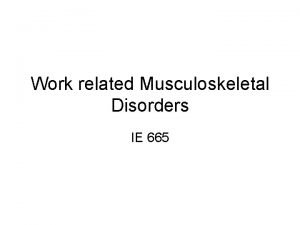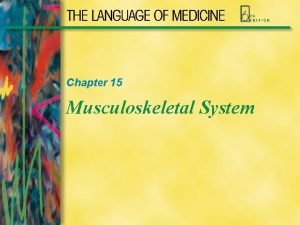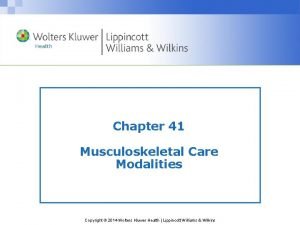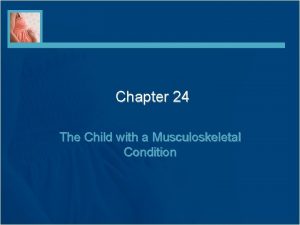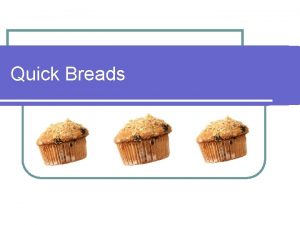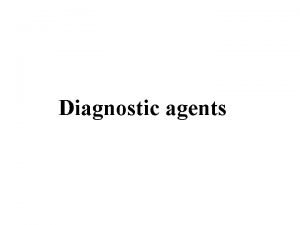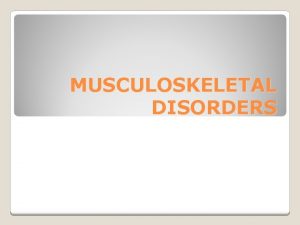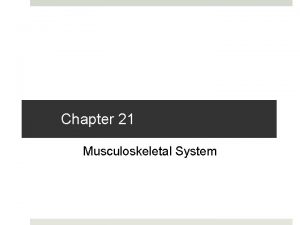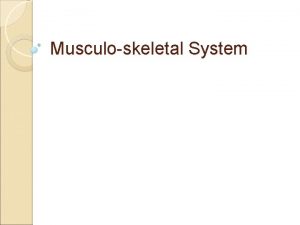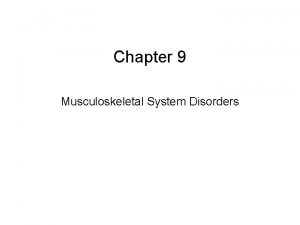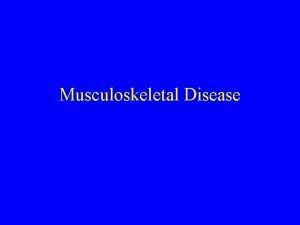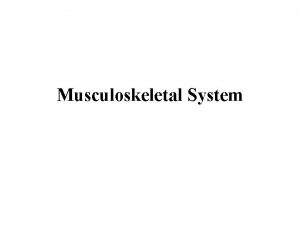Chapter 30 Agents Used in Musculoskeletal Disorders Skeletal










- Slides: 10

Chapter 30 Agents Used in Musculoskeletal Disorders

Skeletal Muscle Also called striated muscle; is attached to the skeleton Contraction is under voluntary control Contraction controlled by the nervous system l l l 2 Copyright 2007 Thomson Delmar Learning, a division of Thomson Learning Inc. All rights reserved.

Agents Used in Musculoskeletal Disorders Nerve impulses travel down the motor neurons of the nervous system l £ Cause skeletal muscle contraction The neuromuscular junction contains the terminal of a motor neuron and a muscle fiber Motor axon terminals contain thousands of vesicles filled with acetylcholine l l 3 Copyright 2007 Thomson Delmar Learning, a division of Thomson Learning Inc. All rights reserved.

Classes of Musculoskeletal Drug Agents Neuromuscular blocking agents Centrally acting skeletal muscle relaxants Direct-acting skeletal muscle relaxants Skeletal muscle stimulants l l 4 Copyright 2007 Thomson Delmar Learning, a division of Thomson Learning Inc. All rights reserved.

Neuromuscular Blocking Agents Action l £ £ 5 Block the action of acetylcholine Mimic acetylcholine action and prevent cholinesterase from working; the muscle becomes overtired and the client is unable to use the muscle (continues) Copyright 2007 Thomson Delmar Learning, a division of Thomson Learning Inc. All rights reserved.

(continued) Neuromuscular Blocking Agents Relax or paralyze the skeletal muscles Used for: l l £ £ Surgery Electroconvulsive therapy Endotracheal intubation Tetanus treatment 6 Copyright 2007 Thomson Delmar Learning, a division of Thomson Learning Inc. All rights reserved.

Centrally Acting Skeletal Muscle Relaxants Depress the CNS in the brainstem, basal ganglia, and neurons of the spinal cord Do not act on the neuromuscular junction Relieve pain associated with skeletal muscle spasms—cerebral palsy High risk: sedation l l 7 Copyright 2007 Thomson Delmar Learning, a division of Thomson Learning Inc. All rights reserved.

Direct-Acting Skeletal Muscle Relaxants Inhibit calcium release from the skeletal muscles Muscle is then less responsive l l £ £ Dantrolene acts directly on skeletal muscle; relaxes spastic muscle Used in the treatment of multiple sclerosis, cerebral palsy, and stroke 8 Copyright 2007 Thomson Delmar Learning, a division of Thomson Learning Inc. All rights reserved.

Skeletal-Muscle Stimulants Correct muscular weakness such as myasthenia gravis Inhibits the action of anticholinesterase; more acetylcholine is available to cause and maintain the muscle contraction l l 9 (continues) Copyright 2007 Thomson Delmar Learning, a division of Thomson Learning Inc. All rights reserved.

(continued) Skeletal-Muscle Stimulants Side effects/adverse effects l £ Caused by unusual cholinergic activity u u u Increased salivation Diarrhea Intestinal cramping Bradycardia Miosis 10 Copyright 2007 Thomson Delmar Learning, a division of Thomson Learning Inc. All rights reserved.
 Chapter 6 musculoskeletal system
Chapter 6 musculoskeletal system Work related musculoskeletal disorders definition
Work related musculoskeletal disorders definition Chapter 21 the musculoskeletal system
Chapter 21 the musculoskeletal system Knuckle like process at the end of a bone
Knuckle like process at the end of a bone Chapter 40 musculoskeletal care modalities
Chapter 40 musculoskeletal care modalities Buck's extension traction
Buck's extension traction Leavening agents in quick breads
Leavening agents in quick breads Pour batter examples
Pour batter examples Leavening agents used in quick breads
Leavening agents used in quick breads Additives used in liquid dosage form
Additives used in liquid dosage form Diagnostic agents are the compounds used to
Diagnostic agents are the compounds used to

